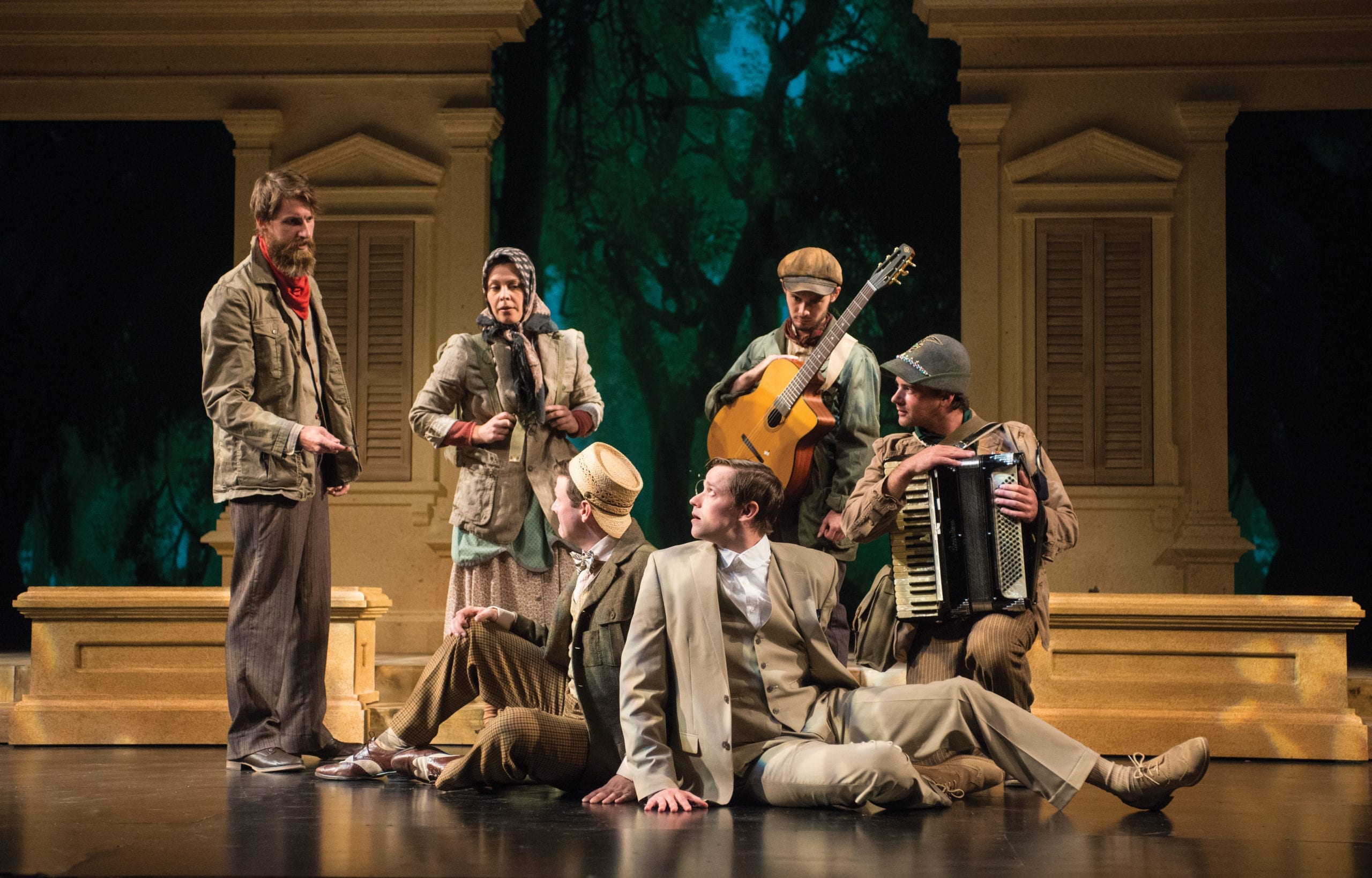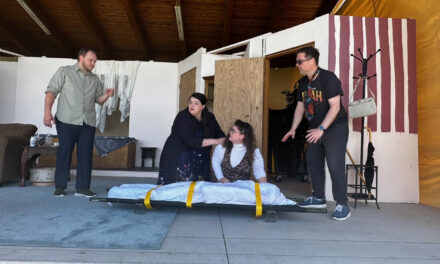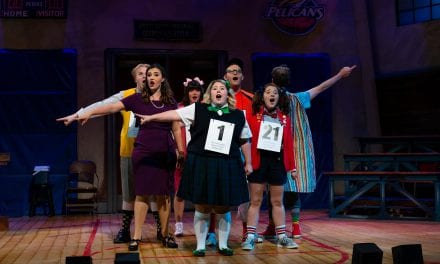CEDAR CITY — Treachery against friends was seen as so despicable that few people could find redemption from it. Dante Alighieri famously put traitors in the lowest circle of hell and reserved punishments for them that were worse than the punishments for murder, adultery, or theft. Despite the vile nature of their acts, Shakespeare manages to find redemption for a traitor in The Two Gentlemen of Verona. This story of betrayal and forgiveness is on stage this fall at the Utah Shakespeare Festival in a production that imbues a surprising amount of depth and nuance into this comedy.

John Maltese (left) as Valentine and Tasso Feldman as Proteus in the Utah Shakespeare Festival’s 2015 production of The Two Gentlemen of Verona. (Photo by Karl Hugh. Copyright Utah Shakespeare Festival 2015.)
In the first scene of The Two Gentlemen of Verona, lifelong friends Valentine and Proteus prepare to separate. Valentine is leaving for Milan to seek his fortune, while Proteus stays behind in Verona because of his love for Julia. Soon after, Proteus’s father sends him away to Milan, which pains the young man because it means he will be separated from his love. When he arrives in Verona, Proteus falls instantly in love with Silvia, the daughter of the Duke of Milan—with whom Valentine has already fallen in love. Proteus then plots against his friend and works to capture the heart of Silvia for himself.
Director Robynn Rodriguez was effective in mining the script for humor. Unlike Shakespeare’s most beloved comedies (like A Midsummer Night’s Dream or Much Ado About Nothing), very little of the main characters’ dialogue is funny on paper. Rodriguez helped her leading actors create genuinely funny moments, such as when Valentine realizes that he is the recipient of the love letter he penned on Silvia’s behalf. I also appreciated how Rodriguez set up the almost fraternal relationship between the two title characters, which paid off in the last scene when each man is furious with the other. This provided a satisfying contrast and also created a rising tension that is not explicit in the script.

A scene from the Utah Shakespeare Festival’s 2015 production of The Two Gentlemen of Verona. (Photo by Karl Hugh. Copyright Utah Shakespeare Festival 2015.)
As Valentine, John Maltese’s schoolboy looks and sweet demeanor make it easy to believe that he would foolishly fall in love with a woman he just met. These character traits also made it clear why Valentine would fall victim to his friend’s machinations and schemes. Maltese also made it easy to feel pathos for Valentine as the character was banished from Milan and separated from Silvia.
Tasso Feldman played Proteus with a surprising level of depth and range. His early scenes elicited a splattering of sympathetic “ahs” and “ohs” for Proteus as he bared his lovesick soul to the audience. Yet, Feldman later peeled back Proteus’s sweet exterior to reveal a devious layer of the character that never became cartoony. Feldman was also saddled with several soliloquies that he delivered directly to the audience, and he executed these difficult pieces with ease.

Betsy Mugavero as Julia in the Utah Shakespeare Festival’s 2015 production of The Two Gentlemen of Verona. (Photo by Karl Hugh. Copyright Utah Shakespeare Festival 2015.)
Betsy Mugavero gave another noteworthy performance in this plays a Julia, Proteus’s gilted lover. In her first scene, when Julia swoons over a love letter from Proteus, Mugavero was supremely charming. And when Julia decides to follow her love to Milan disguised as Sebastian, Mugavero donned a dapper suit and became a more convincing man than most actresses do in similar roles. Additionally, she and Feldman create a believable romantic couple, which made Julia’s heartbreak understandable when she learned that Proteus was pursuing Sylvia.
The only shortcoming among the cast is the performance from Chris Mixton as Proteus’s servant, Launce. Despite being given some of the few naturally funny lines of dialogue in the play, Mixton failed to breathe energy into his character. The contrast between his flat delivery of Launce’s monologues (such as when describing his dog’s bad behavior at a banquet) with the much funnier Michael Doherty as Speed—even though Doherty had less comic material to work with—was disappointing.

Michael Doherty (left) as Speed and John Maltese as Valentine in the Utah Shakespeare Festival’s 2015 production of The Two Gentlemen of Verona. (Photo by Karl Hugh. Copyright Utah Shakespeare Festival 2015.)
The most prominent visual feature of the play is Bill Forrester‘s neoclassical set. With arches, columns, and windows, and balconies, the cream-colored façade serves as a constant reminder of the play’s Italian setting. Moreover, it served as a satisfying frame for the lush, colors that lighting designer Kirk Bookman projected onto the white backdrop. The neutral colors of the set also made the actors pop out from the background, especially when dressed in the fine 1920’s period costumes provided by David Kay Mickelsen. Although each visual element worked well on its own, the three artists’ work blended together into a coherent whole that is rarely accomplished in live theatre.

Michael Doherty (left) as Speed and Chris Mixon as Launce in the Utah Shakespeare Festival’s 2015 production of The Two Gentlemen of Verona. (Photo by Karl Hugh. Copyright Utah Shakespeare Festival 2015.)
With this play likely being Shakespeare’s earliest comedy, it is rewarding to watch The Two Gentlemen of Verona and see Shakespeare use for the first time the tropes that would become the hallmarks of his works. The Two Gentlemen of Verona has a cross-dressing woman, love at first sight, a balcony scene, clowns, and a message on the importance of forgiveness. Much like Titus Andronicus, watching The Two Gentlemen of Verona is thrilling, as this play gives Bardophiles a chance to see the genesis of these techniques, used more masterfully in later masterpieces.
That’s not to say that The Two Gentlemen of Verona is a stunning success. The script lacks fully developed subplots, and Shakespeare dwells too long on verbal puns (like “doubling” and “doublet,” “understand” and “stand under,” “soul” and “sole,” or “vanished” and “banished”). Yet, in the words of Silvia in Act II, the play is “a fine volley of words.” The simple story makes the play easy to understand, and the lack of unnecessary characters gives the play a clean, edited feel—even when performed in its entirety as it is in the Utah Shakespeare Festival’s production.
Overall, the Utah Shaksepeare Festival has created a production of The Two Gentlemen of Verona that is so good that the play takes on “underappreciated gem” status before intermission comes. The deft directing, the endearing cast, and the inviting visual aspects of the play make The Two Gentlemen of Verona worth the trip to Cedar City.





